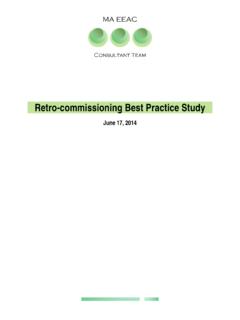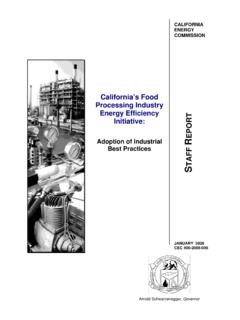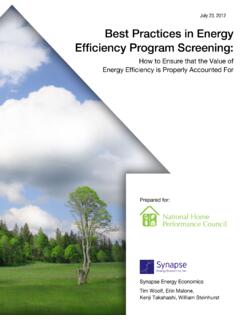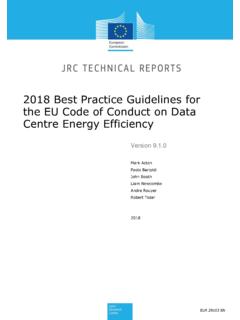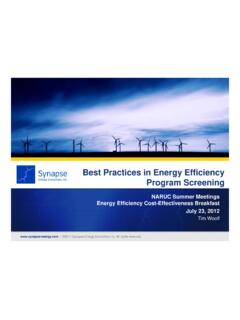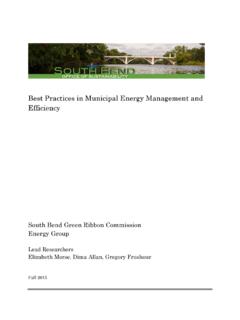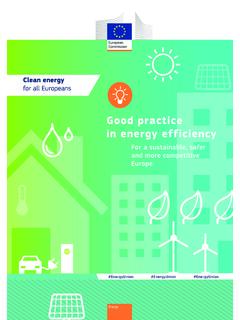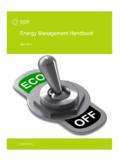Transcription of Health Care Best Practices Study - MA Energy …
1 Health Care best Practices Study FEBRUARY 3, 2015. Table of Contents Acknowledgements .. 2. Executive Summary .. 3. 4. Market Characterization .. 4. Process .. 9. 10. Potential Health Care Sector Program Elements .. 11. Hospital Retro-commissioning .. 15. Next Steps .. 15. Conclusion .. 16. Appendix A: best Practice Criteria .. 17. Appendix B: Program Elements .. 18. Appendix C: Health Care Programs in Other Jurisdictions .. 19. Appendix D: List of Disproportionate Share Hospitals .. 22. Appendix E: Approved Work Plan .. 24. Appendix F: Approved Interview Guides.
2 26. Appendix G: List of Completed Interviewees .. 31. Health care best Practices Study 1. Acknowledgements This Study was led by Cliff McDonald (Optimal Energy - Massachusetts Energy efficiency Advisory Council [EEAC] Consultant Team), with active participation by Jennifer Chiodo (Cx Associates - EEAC Consultant) and staff from Massachusetts Program Administrators (PAs) including Dave Gibbons (National Grid), Nelson Medeiros (NU), Paul Giguere (Columbia Gas), Sneha Sachar, (National Grid), Tom Palma (Unitil), Erik Mellen (NU), Naomi Mermin (PA Consultant), and Doug Baston (PA Consultant).
3 We recognize the contributions of Program Managers for CenterPoint Houston, Southern California Edison, Vermont Energy Investment Corporation ( efficiency Vermont), Northwest Energy efficiency Alliance, and Public Service Electric & Gas who participated in in-depth interviews and provided information regarding their programs, lessons learned, and Health care sector services. We also appreciate contributions from Massachusetts Stakeholders and hospital staff including Chai Srisirikul, John Lombardi, Tom Hodovanec, Michael Grimmer, Bob Biggio, Angel Agleico, and Paul Lipke.
4 We appreciate the time and information they provided in support of this research. Health care best Practices Study 2. EXECUTIVE SUMMARY. This paper describes the results from a Study conducted by the Massachusetts EEAC Technical Consultants with input from the Massachusetts Program Administrators (PAs). The Study purpose was to investigate key factors affecting the Health care market and to identify program elements that effectively advance Energy efficiency in the 1. Health care sector for consideration as potential best Practices .
5 The current Massachusetts programs are very strong in achieving savings with large hospitals, and expansion of existing programs and adoption of new strategies identified in this Study could help the Massachusetts PAs achieve higher levels of participation and savings in mid-sized and smaller facilities in this critical sector. The Study finds several program elements that could be implemented or expanded to enhance savings in the Health care sector: Comprehensive support including audits, scoping, project management, and incentives.
6 2. An enhanced approach to Memoranda of Understanding Educating facility managers on building a business case for Energy efficiency projects Continuous engagement and outreach through organizations such as the American Society of Healthcare Engineering (ASHE). Using market specialists for outreach in the sector Cost sharing between PAs and customers for a Resource Conservation Manager (RCM). An RCM would be an employee of the hospital whose job it would be to identify and implement Energy savings measures, with a focus on low- and no- cost measures.
7 Working collaboratively with representatives from multiple facilities to create a shared set of goals and technical resources Raising incentive amounts for small to medium sized facilities to achieve higher savings and increased participation This Study takes the initial step at identifying Practices which have potential to further advance Energy efficiency in Massachusetts. Additional research into the potential for integrating new Practices into the existing PA programs includes as developing estimates of costs and savings potential, gathering more detailed information of specific implementation criteria for elements of interest and trying Practices with a limited customer group will be necessary before state-wide adoption of these Practices occurs.
8 In some cases the Study identified best Practices that are already in use in Massachusetts and recommends expanding the application of those successful Practices to more of the market which will also require PA analysis to identify and articulate the thresholds beyond 3. which the strategies will not be applied and the rationale for those thresholds. This Study did not explicitly explore the cost effectiveness of implementing these Practices . However, all of the Practices identified in the Study are in use by PAs in other states.
9 The PAs who employ these effective program elements consistently reported that the Practices are cost effective and are meeting the needs of the Health care 4. market. For the most part, evaluation data on the specific program elements is not available, as they are integral parts of larger efficiency programs, or new programs that have not yet been evaluated. The approach used in the report, therefore, relies on the combined experience of the PA/Consultant Team to come to a consensus on which Practices have the greatest potential to provide the desired benefits of increased cost effective savings and higher levels of participation across the Massachusetts Health care sector.
10 1 The Study initially considered looking across the full Health care market including large, medium and small hospitals, continuing care facilities, and medical office buildings. The working group determined that these sub-segments were too diverse to Study comprehensively within the time and budgetary limitations of this Study and selected medium/small hospitals as the primary area of focus for the Study . 2 Currently in place for largest electric customers served by National Grid and Northeast Utilities 3 A commonly cited rationale for not expanding resource intensive Practices such as MOUs to smaller customers is cost effectiveness limits.
